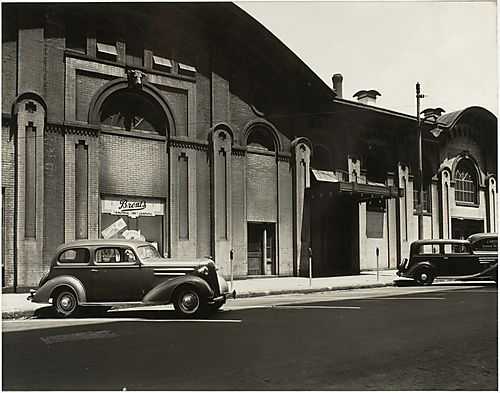Secret Pittsburgh
The Rebirth of the North Side
By Lauren Dundore
The North Side neighborhood of Pittsburgh is one of contrasts—a conflict between the old and the new, revitalization and rich history, and the past and the future. When exploring the North Side, you are entirely immersed in a flourishing and diverse culture. You can see the influences of different decades, styles, and values in the buildings scattered throughout the neighborhood and the people who live there. However, this cohesiveness of changing times wasn’t always the case. The North Side has a dark history—depicting the struggle between preserving the past and urban renewal, which has continued to plague the Pittsburgh area for decades. Though not entirely defeated by the city’s attempts to revitalize, the neighborhood has prospered and its residents have learned to fight back in the years since, struggling to preserve the history that they call home. We will see the transformation of the North Side through the use of photographs. As John Berger once wrote, photographs are valuable to us because they are capable of “offering direct access to the real” (52). Through photographs, we gain insight into a world, a time, to which we are outsiders.
Once a city rich with industrialization during its heyday in the steel industry, Pittsburgh fell into the depths of pollution and poverty as the well-to-do retreated out of the city and into its surrounding suburbs. Between the years of the two World Wars, journalists, like H.L. Mencken, took to their writing describing it as the city with, "unbroken and agonizing ugliness" and "sheer revolting monstrousness of every house in sight." Pittsburgh became a city full of crowded and poorly built homes, thick smoke, flooding, sewage in the water, and decreasing property values (Fitzpatrick). Figure 1 depicts what life looked like for the residents of the predominately black populated North Side in the year 1950, showing the level of poverty and living conditions of its residents on a typical neighborhood street. Because of these conditions, business leaders knew something had to be done to transform Pittsburgh into the city of their dreams—one that was safe, friendly, and modern.
In the second half of the 20th century, the revitalization of Pittsburgh was underway with more than $5 billion being spent to rebuild Pittsburgh and its old neighborhoods. To lure residents back into the city life, new highways were constructed along with the hope to make Pittsburgh a more attractive place to live (Fitzpatrick). These highways, including the Parkway East, were built amidst existing neighborhoods and structures in the North Side. The hallmark of the North Side was the Old Allegheny Market House, which had stood in the same spot in the heart of the neighborhood since 1863, even before its annexation into the city of Pittsburgh in 1907 (Suisman). The Market House, seen in Figure 2 in the same year as its demolition, was a historic staple to the North Side, as it housed the neighborhood’s food sources, including a bakery, butcher, and a drugstore, among other vendors. As a part of the urban redevelopment movement, the beloved Market House, along with the neighboring Ober Park, was torn down in 1965 to make way for the construction of the Allegheny Center, which included high rise apartment houses and a mall (Fitzpatrick). Not only did the renewal bring about the construction of new sites and opportunities for the people of Pittsburgh, but it also caused the destruction of the existing structures and the lives of those who called the neighborhood home. With this monumental renewal of the North Side, the neighborhood was deep in its struggle between preserving the past and looking to the future. During this time, highways, community centers, and office buildings were created for the sake of “community improvement”. While Pittsburgh and its surrounding areas created new and modern structures for work, commuting, and recreation, these old and historic neighborhoods and the buildings that called those places home were demolished and reconstructed, as communities were removed and homes destroyed all in the hope to halt the mass exodus of workers to the suburbs. While the city worked for community improvement, it did not better the lives of everyone involved. These losses still remind us today to be vigilant in the protection of our historic resources and aware of the consequences that our actions may have on others.
Out of the struggle to preserve the past and history of Pittsburgh’s neighborhoods came preservation societies, some of which are still in action today. In 1964, when preservationist Arthur Zeigler got wind of the city’s plans to demolish the neighborhood of Manchester and other parts of the North Side, he along with historian and architect James Van Trump created the Pittsburgh History and Landmarks Foundation. With their money, these two men and their foundation began to restore homes in the historic North Side, including those that are part of the Mexican War Streets. These newly renovated homes were then rented out to low-income and minority families. They also made an unsuccessful attempt to save the Old Allegheny Market House. Not only did they advocate in the North Side, but throughout the rest of Pittsburgh, including the Strip District and the South Side (Fitzpatrick). Today, the Pittsburgh History and Landmarks Foundation continues its work in renewing communities and creating sustainable economic development through historic preservation, rather than widespread demolition (“About”).
Tucked amidst the streets of this historic neighborhood, The Mattress Factory marries the old and the new, the sane and insane, together through artwork. This “hidden” museum lets you explore the neighborhood and its surrounding sites, as it perfectly blends in with the rest of the buildings around, consisting of different sites scattered throughout a few city blocks. Born out of the later years of the North Side’s urban renewal in the 1970s, the buildings now pay homage to both the past and that time of change through their use of materials and themes in the artwork. The art addresses societal concerns that are reflected in the urban world around us, and not just in Pittsburgh, but world-wide too, as seen in Figure 3 which envelops museum-goers in the personal narrative of artist Mohammed Musallam who was exiled from his home in Palestine. Not only the artwork, but the building itself, the bones of the infrastructure, offers a look into the industrial history of the North Side, and celebrates the past through keeping the integrity of the building intact. As said on the Mattress Factory’s website, the museum has been a vital part of the area, and has lead the way for good to come out of its existence. The Mattress Factory cites its own community revitalization efforts within the neighborhood, including rehabilitating abandoned properties, contributing to the economic impact of the Pittsburgh area, and even making significant additions to the local workforce, tourism, as well as maintaining the cultural identity of the city (“History”).
Though overshadowed by revitalizations in East Liberty and the Hill District, the renewal of the North Side was a vital and drastic change for the city of Pittsburgh in their fight for upgrading to a more modern and clean city through demolition and new construction. Once an area of prosperous living, this neighborhood’s history led it on a cycle down into the depths of poverty and then through a revitalization period which transformed the neighborhood, the effects of which we still feel today. The novel Tomorrow and Tomorrow has a theme that very closely relates to the struggle between the past and the future that has plagued the Pittsburgh revitalization movement. This novel reminds us to hold on to the memories of the past and not try to replace them, because once what you love is gone, it is gone forever. This is especially seen through the quote, “He didn’t want the house to simply vanish, he didn’t want it to be buried over…and disappear, rebuilt as something new in a city with amnesia” (Sweterlitsch, 309). Like the character in this quote, we must want to preserve and honor the history of our cities, and not have the past be built over and forgotten.
Works Cited
A. Church Photographers. “North Side Market House.” Allegheny Conference on Community Development Photographs, 1965, Historic Pittsburgh.
"About." Pittsburgh History & Landmarks Foundation. http://phlf.org/about/overview/.
Berger, John. About Looking. New York: Vintage International, 1991.
Eagle, Arnold. “Neighborhood: North Side Backyard.” Carnegie Museum of Art Collection of Photographs, 1950, Historic Pittsburgh.
Fitzpatrick, Dan. "The Story of Urban Renewal." The Post Gazette, 21 May 2000. http://old.post-gazette.com/businessnews/20000521eastliberty1.asp.
"History." The Mattress Factory. http://mattress.org/content/history.
Musallam, Mohammed. The Great Illusion, 2016. Photograph taken by Anmol Baxi, Accessed 2 Feb. 2017.
Suisman, Doug. "The Next Page: Reviving the North Side's 'Lost City'." Pittsburgh Post-Gazette, 08 Apr. 2007. http://www.post-gazette.com/opinion/Op-Ed/2007/04/08/The-Next-Page-Reviving-the-North-Side-s-Lost-City/stories/200704080370.
Sweterlitsch, Thomas. Tomorrow and Tomorrow. New York: Berkley Group, 2015.


